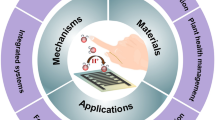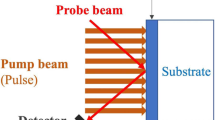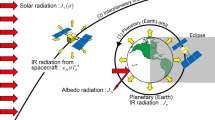Abstract
In this paper, we propose a passive wireless temperature sensor for long-term and long-range application. A novel architecture of the wireless temperature sensor is proposed based on backscattering mechanism of RFID technology for ultra-low power application. The temperature sensor adopts phase-locked loop-based architecture and can achieve the temperature-digital conversion in frequency domain without any external clock signal. The rectifier employs a gate-boosting scheme to improve the power conversion efficiency. The measurement results show that the proposed wireless temperature sensor obtains a high linearity with a resolution of 0.3 °C/LSB. The measured minimum power dissipation is 2.7 µW, resulting in a maximum operating distance of 34 m under 4 W radiation power.










Similar content being viewed by others
References
Sung, W. T., Chen, J. H., & Chang, K. Y. (2013). ZigBee based multi-purpose electronic score design and implementation using EOG. Sensors and Actuators, A: Physical, 190(1), 141–152.
Kumar, A., & Hancke, G. P. (2014). Energy efficient environment monitoring system based on the IEEE 802.15.4 standard for low cost requirements. IEEE Sensors Journal, 14(8), 2557–2566.
Depari, A., Flammini, A., Rinaldi, S., & Vezzoli, A. (2013). Multi-sensor system with Bluetooth connectivity for non-invasive measurements of human body physical parameters. Sensors and Actuators, A: Physical, 202(10), 147–154.
Deng, F., He, Y., Zhang, C., & Feng, W. (2014). A CMOS humidity sensor for passive RFID sensing applications. Sensors, 14(5), 8728–8739.
Qi, Z., Zhuang, Y., Li, X., et al. (2014). Full passive UHF RFID tag with an ultra-low power, small area, high resolution temperature sensor suitable for environment monitoring. Microelectronics Journal, 45(1), 126–131.
Sebastiano, F., Breems, L. J., Makinwa, K. A. A., et al. (2010). A 1.2 V 10 µW NPN-based temperature sensor in 65 nm CMOS with an inaccuracy of ± 0.2 °C (3 s) from − 70 °C to 125 °C. In IEEE solid state circuits conference digest of technical papers, (pp. 312–313).
Souri, K., Chae, Y., & Makinwa, K. A. A. (2013). A CMOS temperature sensor with a voltage-calibrated inaccuracy of 0.15 C (3σ) from 55 °C to 125 °C. IEEE Journal of Solid-State Circuits, 48(1), 292–301.
Wang, B., Law, M. K., Bermak, A., et al. (2017). A passive RFID tag embedded temperature sensor with improved process spreads immunity for a − 30 °C to 60 °C sensing range. IEEE Transactions on Circuits and Systems I: Regular Papers, 61(2), 337–346.
Man, K. L., Bermak, A., & Luong, H. C. (2010). A sub-µW embedded CMOS temperature sensor for RFID food monitoring application. IEEE Journal of Solid-State Circuits, 45(6), 1246–1255.
Zhou, S., & Wu, N. (2007). A novel ultra low power temperature sensor for UHF RFID tag chip. In IEEE Asian solid-state circuits conference, (pp. 464–467).
Vaz, A., Ubarretxena, A., Zalbide, I., et al. (2010). Full passive UHF tag with a temperature sensor suitable for human body temperature monitoring. IEEE Transactions on Circuits and Systems II: Express Briefs, 57(2), 95–99.
Reinisch, H., Wiessflecker, M., Gruber, S., Unterassinger, H., Hofer, G., Klamminger, M., et al. (2011). A multifrequency passive sensing tag with on-chip temperature sensor and off-chip sensor interface using EPC HF and UHF RFID technology. IEEE Journal of Solid-State Circuits, 46(12), 3075–3088.
Vaz, A., Ubarretxena, A., Zalbide, I., & Pardo, D. (2010). Full passive uhf tag with a temperature sensor suitable for human body temperature monitoring. IEEE Transactions on Circuits & Systems II Express Briefs, 57(2), 95–99.
Yin, J., Yi, J., Law, M. K., Ling, Y., Lee, M. C., Ng, K. P., et al. (2010). A system-on-chip EPC gen-2 passive UHF RFID tag with embedded temperature sensor. IEEE Journal of Solid-State Circuits, 45(11), 2404–2420.
Wei, P., Che, W., Bi, Z., Wei, C., Na, Y., Qiang, L., et al. (2011). High-efficiency differential RF front-end for a Gen2 RFID tag. IEEE Transactions on Circuits & Systems II Express Briefs, 58(4), 189–194.
Danneels, H., Piette, F., de Smedt, V., Dehaene, W., & Gielen, G. (2011). A novel PLL-based frequency-to-digital conversion mechanism for sensor interfaces. Sensors and Actuators, A: Physical, 172, 220–227.
Acknowledgements
This work was supported by Natural Science Foundation of China (51767006), Key Research and Development Plan of Jiangxi Province (20161BBE50075), Natural Science Foundation of Jiangxi Province (20171BAB206045), Science and Technology Project of Education Department of Jiangxi Province (GJJ160491, GJJ170378).
Author information
Authors and Affiliations
Corresponding author
Rights and permissions
About this article
Cite this article
Chen, Z., Deng, F., Fu, Z. et al. Design of an Ultra-low Power Wireless Temperature Sensor Based on Backscattering Mechanism. Sens Imaging 19, 24 (2018). https://doi.org/10.1007/s11220-018-0207-x
Received:
Revised:
Published:
DOI: https://doi.org/10.1007/s11220-018-0207-x




